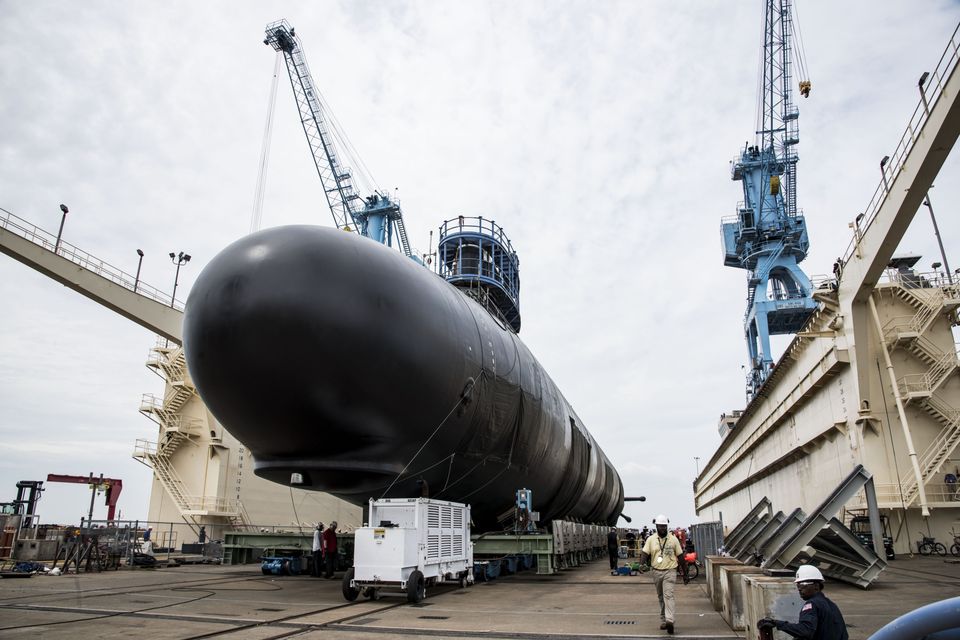
Large military contractors are indicating they’re now ready to invest in their facilities and manufacturing capacity despite so much uncertainty around the Pentagon’s spending levels this current year and into Fiscal Year 2019.
Executives from some of the largest defense contractors, in earnings calls and conversations this week with Wall Street analysts, detailed their plans to increase their planned capital expenditures this year and in the next few years.
“We will spend $1.7 billion in CapEx (capital expenditures) at Electric Boat over the next several years in anticipation of increased production on the Block V Virginia submarine and the new Columbia ballistic-missile submarine,” General Dynamics chief executive officer Phebe Novakovic told analysts last week, according to a transcript of the call provided by Seeking Alpha.
“This is very much driven by an expectation of increased business,” defense industrial base analyst Andrew Hunter told USNI News.
Hunter, the director of the Defense-Industrial Initiatives Group and a senior fellow at the Center for Strategic and International Studies, said defense spending typically runs in cycles that last about a decade from spending peak to spending peak.
Military spending was down until about 2015, he said. Industry responded by not reinvesting in their facilities or increasing manufacturing capacity. Since then, Hunter said the Pentagon has steadily increased its number of contracts.
According to his Defense Acquisition Trends report released in March, Hunter found Missile Defense Agency (MDA), Air Force, and the Navy all saw significant increases in contract obligations in 2016, driven primarily by increased obligations for large procurement programs like the C-130J transport aircraft, the KC-45A tanker aircraft, and the Trident II missile program. Hunter is working on an updated version of the report, due out in the Spring.
For the upcoming Fiscal Year 2019, Hunter said the Department of Defense has made it known spending will increase, possibly by as much as 7 percent, according to some estimates. The result, Hunter said, is that contractors are telling analysts and the Pentagon that they’re ramping up production capabilities to handle multi-year contracts now being funded. Hunter mentioned Northrop Grumman’s B-21 program and General Dynamics submarine projects as examples. Raytheon, he added, is successful at spending money on building new products the company hopes to sell to the military.
“To me, industry is responding to a department signal, ‘we are ready to buy,'” Hunter said.
Starting in 2018, and for the next few years, General Dynamics plans to increase the company’s total capital expenditures to about 2 percent of revenues. The company came in shy of that percentage in recent years, said Jason Aiken, chief financial officer at General Dynamics, during the conference call with analysts.
In 2017, General Dynamics spent $428 million on capital expenditures, whereas 2 percent of its 2017 revenues of $31 billion would have totaled $620 million, according to data from the company’s Securities and Exchange Commission filings.
In 2016, General Dynamics spent $392 million on capital expenditures, but had the company spent 2 percent of revenues on capital expenditures the figure would have been closer to $630 million.
The General Dynamics target of dedicating two percent of revenue for capital improvements would have meant spending roughly $629 million in 2015 and $617 million in 2014. Yet, according to the company’s financial reports, capital expenditures for those years were $569 million and $521 million, respectively.
General Dynamics is hardly alone, though, when it comes to having scaled back capital expenditures earlier in the decade, Hunter said. Companies are not going to spend a lot of money improving their facilities if those investments will take too long to pay off, if the military buys fewer goods or gives companies smaller profits in their contracts. Everyone scales back capital expenditures when military spending drops, he said.
Northrop Grumman spent about $900 million on capital expenditures in 2017, according to company’s financial reports. This year, the company plans to increase such spending to about $1 billion.
Lockheed Martin officials told analysts during an earnings call they plan increase their capital expenditures to about $1.3 billion both 2018 and 2019, from close to $1.1 billion last year.
When Textron CEO Scott Donnelly spoke with analysts on Wednesday, he explained the company was increasing capital spending to about $225 million to help secure more contracts, according to a transcript provided by Seeking Alpha. Textron has been positioning itself to support the Navy and Air Force adversary air programs ever since it purchased Airborne Tactical Advantage Co. in 2016. Donnelly said the Navy is preparing their proposals for projects and the Air Force is conducting industry days. Textron also hopes to expand its V-22 Osprey program its Scorpion and AT-6 jets.
“So, the only tough part of this for us is you got to get out in front of it and spend the capital to have the assets and get everything prepared in terms of maintenance facilities and demos, Donnelly said. “So, there’s a little bit of a drag, frankly, in there to support that, but it’s a huge growth opportunity and one that seems to be materializing.”





